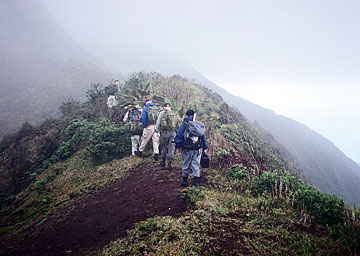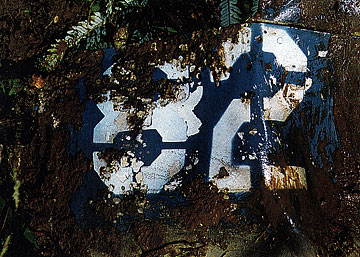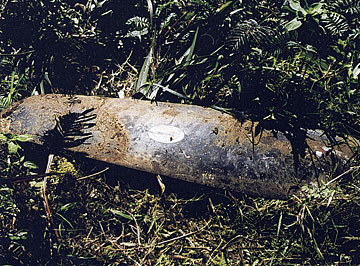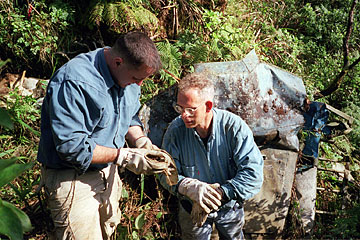Koolau recovery mission
A military team will dig in the Koolaus for the remains of a World War II aviator
AFTER a nearly a decade of planning and setbacks, military forensic specialists next month will try to recover the remains of World War II Navy aviator who crashed his F-6F Hellcat into a Koolau Mountain ravine in June 1944.
James Pokines, who will head a team of nearly a dozen recovery specialists from the Joint POW/MIA Accounting Command at Hickam Air Force Base, expects to find remains belonging to Ensign Harry "Bud" Warnke. The military has said Warnke was buried at the crash site at the 2,600-foot level, above the southern entrance to the H-3 tunnel.

STAR-BULLETIN FILE PHOTO
Nine members of a recovery team searched in February 1999 for the long-abandoned wreckage of a Hellcat fighter plane that crashed into the Koolaus in 1944.
|
|
His sister, Myrtle Tice, who has been waiting for more than six decades, is hoping that "we do something and get this done ... We've been waiting a long time.
"Wouldn't it be great?" said Tice, 86, who lives south of Tucson, Ariz. She wants to bury her brother in her family plot in Westville, a farming community in northern Indiana where her parents are buried. A headstone honoring Warnke sits over an empty grave.
Tice said she periodically reviews the weather reports for Hawaii after the Navy last year initiated an environmental study justifying a recovery mission. "It looked like pretty good for July," she said. "I've been waiting for a long time."
Pokines, who has been with JPAC for 6 1/2 years, said he expects to find Warnke's remains because a past inspection found the Hellcat crash site.

STAR-BULLETIN FILE PHOTO
Also shown are pieces of the wreckage of the plane with the number "82" -- Ensign Harry Warnke's (shown at top) aircraft number -- that the team recovered in 1999.
|
|
"It is his aircraft and it is in the right location," said Pokines. "We have to make sure that biological profile matches.
"If we had to, we could do DNA testing (with his sister)."
If any remains are found they will be taken to Central Identification Laboratory at Hickam, considered the world's premiere forensic operation.
LAST YEAR, the Navy sought comment on an environmental assessment to recover the remains on conservation land owned by the state departments of Transportation and Hawaiian Home Lands. Military officials had hoped to undertake a recovery mission last summer.
In its final report, the state Transportation Department said the recovery mission, which could take as long as a month, depending on the weather conditions in the Koolaus, would pose no significant impact on the environment.
Pokines, 40, said part of the delays can be attributed to having to develop a low-impact plan to excavate, since the crash site is in a natural preserve and watershed area, and because of cultural and historical concerns.
Pokines' team during the July mission will cover an area up to 478 square yards around the crash site, which is on a steep incline.
However, unlike on most JPAC overseas missions, his team won't screen the dirt for remains and other relics at the site.
Instead, with the help of Hawaii Army National Guard helicopters, the dirt from the recovery area will be sling-loaded to Camp Smith and either screened there or at JPAC's headquarters at Hickam. The JPAC team will hike to the excavation site each day.
Pokines said during one of the two times he examined the site he realized that screening would have to be done somewhere else. "It's wet clay, which makes it very hard to screen."
Water, which is needed to screen the dirt, is scarce at that altitude, Pokines said, and it also would cause major environmental problems if that much water was used to screen the dirt at the site.
He estimated that no more than 106 cubic yards of dirt will be removed for screening and that the deepest the team will dig is about a foot.
Pokines said a helicopter landing zone will be established at the former Coast Guard Omega Station in Haiku Valley. He estimated that it will be about 1,400 feet from the crash site.

STAR-BULLETIN FILE PHOTO
This 90-pound propellor was recovered during a 1999 examination of the crash site. A piece of the propellor was given to Warnke's sister, who lives in Arizona.
|
|
"It's only a half-hour walk," Pokines said, "but it is very steep."
Pokines said the recovery mission will be difficult because it rains daily in the Koolaus and this mission will involve sling-loading dirt out of the area.
Past military records indicate that at least a leg and a boot belonging to Warnke were buried near the wreckage on June 17, 1944.
Pokines said "there are no records of the military ever trying to make any type of recovery."
Initially, Warnke's family was told that he crashed his fighter at sea on June 15, 1944. Tice said her parents died believing their son was missing.
However, Warnke, then 23, had taken off from what was then Barbers Point Naval Air Station as part of an eight-plane flight on a training mission. The object of mission was to practice bombing a truck at Kapahi Point, four miles south of Kaneohe Naval Air Station, now called Marine Corps Base Hawaii. Warnke failed to link up with his squadron after making four successful test dives.
IN 1999, the Star-Bulletin accompanied a nine-member recovery team that found the wreckage of what is believed to be Warnke's Hellcat. Debris was scattered over a 65- to 70-degree slope. The crash site covered an area estimated to be 330 feet by 82 feet.
Two 90-pound propeller blades and other pieces of wreckage that bore the number "82," Warnke's aircraft number, were recovered and taken out. The area was mapped, but no attempt was made to dig for remains. A piece of the propeller was sent to Tice.

STAR-BULLETIN / FEBRUARY 1999
In 1999, Maj. Ken Royalty and Capt. Donald Hinton examined part of the wreckage found in the Koolaus. They are members of the recovery team from Joint Task Force Full Accounting. The piece of wreckage has "F-6F" inscribed on it, identifying the plane as the lost Hellcat.
JOINT POW/MIA ACCOUNTING COMMAND
» Mission: To achieve the accounting of all Americans missing from World War II through the Persian Gulf War.
» Recovery teams: 18, consisting of 10 to 14 people including a team leader, forensic anthropologist, team sergeant, linguist, medic, life support technician, forensic photographer, explosive ordnance disposal technician and mortuary affairs specialists.
» Recovery missions: Annually at least five in Korea, 10 in Southeast Asia for Vietnam War, and 10 in other areas of the world associated with World War II and the Cold War.
» Length: 35 to 60 days depending on the location, terrain, and recovery methods.
CENTRAL IDENTIFICATION LABORATORY:
» Staff: 30, the largest staff of forensic anthropologists in the world.
HOW MANY ARE STILL MISSING?
» World War II: 78,000, of which 35,000 have been deemed recoverable. The others are lost at sea or entombed in sunken vessels.
» Korean War: 8,100
» Vietnam War: 1,800
» Cold War: 120
» Gulf War: 1
Source: Joint POW/MIA Accounting Command
|
|

